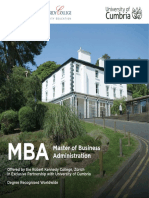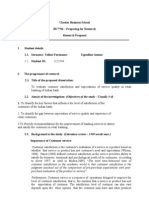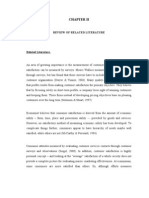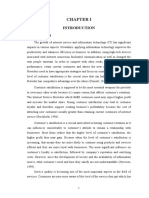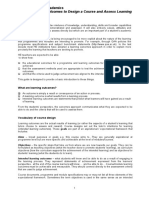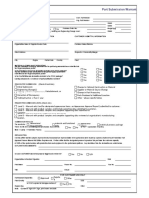Indian Banking
Indian Banking
Uploaded by
aman.4uCopyright:
Available Formats
Indian Banking
Indian Banking
Uploaded by
aman.4uOriginal Description:
Copyright
Available Formats
Share this document
Did you find this document useful?
Is this content inappropriate?
Copyright:
Available Formats
Indian Banking
Indian Banking
Uploaded by
aman.4uCopyright:
Available Formats
A Study of Customer Satisfaction in Indian Banking
Introduction
Businesses need to attract and establish a customer market and would need to retain it through satisfaction. That is the key to its business performance (Johnson et al., 2000). In order to attain this goal, a company should have a high satisfaction rate from its clients. The increasing competition, whether for profit and non profit purposes, is forcing the business sectors to pay much and more attention to satisfying customers (Management library, 2008). Researches suggest that increased levels of customer satisfaction and loyalty are frequently attributed or linked to positive outcomes for a firm (Colgate, 1999). Measurement of the rate of customer satisfaction is also a measurement of how products and services supplied by a company meet or surpass customer expectation. It is seen as a key performance indicator. This is due to the fact that one of the factors needed in order to attain high competency and also high competitiveness is a high market share through an increased, established and well-sustained customer or client population. Industries are beginning to understand the concept that their customers, the ones who purchase their products and use their services, are the primary drivers of their position on the profitability ladder. Satisfaction is a multidimensional construct which has been conceptualized as a prerequisite for building relationships and is generally described as the full meeting of ones expectations (Oliver, 1980), and is a feeling or attitude of a customer towards a product or service after it has been used (Jhan and Khan, 2008). Industries also recognize that the support of the customer requires a complex infrastructure which should not only design, produce, and distribute a product or service
which can be used by the customer without fear of defect, it should also contain a mechanism whereby the customer is effectively supported (Lowenstein, 1997). Anderson and colleagues (19940, found out that firms with higher reported satisfaction levels also show significantly higher returns. They say that an annual 1% increase in customer satisfaction is worth an 11.4% improvement in current return on investment. Companies then need to align their activities and efforts to satisfy and retain customers, agreeing on the importance of customers in driving performance (Johnson et al., 2000). As markets shrink, companies are scrambling to boost customer satisfaction and keep their current customers rather than devoting additional resources to chase potential new customers. This is because it costs five to eight times as much to get new customers than to hold on to old ones is key to understanding the drive toward benchmarking and tracking customer satisfaction (Cacippo, 2000). Many experts have began to focus more directly on increasing customer satisfaction as an explicit goal. Satisfying and keeping customers is simply less expensive than constantly replacing them. They have recognized that quality and satisfaction are not enough to boost the profitability of the business, thus they are moving beyond by focusing directly on customer loyalty as the key (Johnson et al., 2000). Because of this, companies are realigning their efforts and strategic plans towards increasing customer satisfaction and establishing loyalty from the clients or the customers who are purchasing or availing the services being provided by the company. Researchers have also argued that increasing customer loyalty helps to create future revenues (Fornell, 1992), decrease price elasticities (Anderson, 1996) and reduce cost of future interactions (Reicheld and Sasser, 1990). Because of this, organizations are increasingly interested in retaining existing
customers while targeting non-customers, measuring customer satisfaction provides an indication of how successful the organization is at providing products and/or services to the marketplace. The tireless pursuit of improvement would not only increase efficiency but also increase customer satisfaction in the process, saving enough on costs and bringing in enough new and repeat business to more than cover any expenditures quality (Johnson et al., 2000). Basically, customer satisfaction is a psychological state, carefulness should then be taken when measuring it. Competitors that are prospering in the new global economy recognize that measuring customer satisfaction is a key. This is because of doing so, industries can hold on to the customers they have and understand how to better attract new customers (Cacippo, 2000). Customer feedback or measurements of customer satisfaction can help identify at-risk customers, employees and partners before they are lost. Customer satisfaction measurements can also provide valuable insights into new products or services your customers want, putting ones company ahead of the competition (David, 2006). The measurements or surveys of customer satisfaction can be used to measure satisfaction with both internal services such as human resources, information technology, financial, and contracting and external customers (Schay et al., 2000). The companies who will be successful recognize that customer satisfaction is a critical strategic weapon that can bring increased market share and increased profits (Cacippo, 2000). There had been a lot of mechanisms and surveys devised in order to measure the satisfaction level of a number or part of the population toward the performance and services rendered by a certain company which also allows researchers to analyze areas that are important and have much room for improvement (Colgate, 1997).
Because of the growing demand and interests in the customer satisfaction, all industries, including banking industries have been affected by this phenomenon. Some government agencies have also established and deployed an agency wide customer satisfaction survey that represents the best science and practice leading to customer satisfaction (Schay et al., 2000). Banks may differ in their ability and willingness to satisfy customers with their service. Researches suggest that customer satisfaction may be a highly profitable strategy for banks (Faulhaber, ____). Vavra (1995), explains that financial marketers appear to have overlooked the fundamental truth that the longer an institution keeps a customer, the more profitable the customer becomes. Banks then need to maximize their satisfaction with the institutions. Customer satisfaction can be correlated with a number of factors. In a study conducted by Colgate (1997), he has found out that customer service is the most important factor that influences satisfaction rates or levels. Followed by relationship closeness, listening to the needs of customers and value are also of significance. Decisions and discussions regarding the level of service to be provided always include the cost impact and relationship to customer life time value, competitive pressures and the wants and demands of the customers (Taylor reach group, 2004). There is a significant difference in customer and job satisfaction in both private and public sectors. A study showed that layoff threats, quick turnover, less welfare schemes, and less scope for vertical growth increase job dissatisfaction (Bajpai and Deepak, 2004). Experts have developed a structural model which incorporates bank decisions on productivity, risk taking and customer satisfaction into an equilibrium model of banking markets.
Researches have also found out that greater customer satisfaction correlates with greater profitability, principally due to higher levels of demand (Faulhaber, 1995). Increasing customer satisfaction rates, especially in customer relation and services industries such as banking, include the use of upgraded technology in order to reach out for a higher and wider market share and be able to increase profitability. In a study conducted by McKinsey and company on the Indian banking system, it found out that information technology of some leading Indian banks is better than that of banks abroad. The study also finds the level of customer satisfaction in Indian metros is lower than that in rest of Asia (Banknet Grp., 2008). Yet, Indian banks are outperforming their counterparts in Asia and the rest of the world in crucial parameters. The Indian banking market is growing at an astonishing rate, with assets expected to reach US$1 trillion by 2010 (Raja, 2008). It has been a growing trend today, for banks to move away from a transactionalbased marketing approach to a relationship-based approach that has its core the recognition of the lifetime value of the customer. Satisfaction with banking services has been an area of growing interests to researchers and managers. There are a number of studies supporting and reinforcing that customer satisfaction is linked with performance of the banks (Jham and Khan, 2008). Customer satisfaction in the retail banking industry has been studied by a number of researchers including Ahmad (2002), along with customer profitability management being integrated and optimized for the customer (James, 2004). There has been a positive relationship that has been established between equity and satisfaction (Athanassopolous, 2004).
Because of the increasing attention and established recognized significance of customer satisfaction in banking services, and the booming industry and market share of the banking industry in India, there is then an need to understand and discuss the relationship of the economic boom of India due to banking business and the satisfaction rate. Though much studies have been conducted in relation to satisfaction rate in banking industries, few or rare literatures will be found that are dedicated to assessing and evaluating the customer satisfaction levels in India. Also, fewer empirical articles pertaining specifically to the customer satisfaction rate and its relation to the progressive banking industry in India appeared in the literature.
Problem statement
The present study seeks to address a number of factors and unexplained occurrences present in the banking industry in India. The main objective of this research is to study, analyze and asses the customer satisfaction levels in the Indian banking sector and develop a conceptual framework of satisfaction from the perspective of the customer, guided by the basic concepts and principles in marketing and management. This study also aims to study and evaluate the links between customer satisfaction level and level of development or progress in the participating banking companies or firms. In order to do so, the customer satisfaction levels will be assessed using survey that includes parameters that influence much of the satisfaction of the customers. I this research, the focus is on the customer facing level, this will be done by viewing and assessing the opinion and
perspective of the customer in relation to satisfaction with different service parameters, and various services provided by the bank.
Research Objectives
This study has the following specific objectives that would be significant in order to come up with a credible set of data that would the bases for analysis and drawing of the conclusions. 1. To study the customer satisfaction level of different bank firms by assessing and interviewing customers from different establishments; 2. To pin point and identify strong weak points of Indian banking industry that would need to be sustained and those that need to be developed or improved; 3. To provide a set of empirical data that can link relationships between customer level satisfaction and profitability of banking business success; 4. To provide a credible output of research that would be of great and significant contribution to the field useful for professionals in the academics and in practice; 5. To produce an output that is a useful material for project development, strategic planning or as reference for other future studies.
Significance of the Study
The outputs and data that can be drawn from this research will be of great contribution to the field in the academics and for the practitioners. This study will try to assess and evaluate the level of satisfaction of the customers in the banking business in India, thus revealing and studying the salient and influential factors that could affect the satisfaction of the customers. It will also reveal areas and factors that need consideration for improvement. It will also try to link the relationship, if any, of the customer satisfaction level and the success of the firm, in support of the other previous literatures. This study then will ultimately assess and reveal the strong points of the Indian banking and its edges as reasons for the continuous boom and development in it banking industries.
Research Questions
This research study aims to answer the following general and specific questions:
General What is the customer satisfaction level in the Indian banking industry? What are the best or highly rated bank firms in India in relation and in comparison with their customer satisfaction levels?
Specific What are the specific factors that influence the satisfaction level of the customers in the banking industry or sectors in India?
What are the most important factors or elements that banking corporations or firms need to consider? What are the programs or strategic marketing plans observed, developed and implemented by successful banking firms in order to attain high customer satisfaction level, thus, improving market share and increasing profitability? What are the areas or factors of the Indian banking corporation that need or needs to be improved?
Limitations of the study
The study is limited only to top five (5) major banks, as to be determined by the Ministry on Trade and Industry and will only include twenty-five (25) participating customers for each bank. This is inconsideration with the time budget, so as with the financial budget of the researcher.
Review of related literature
Companies now recognize that the new global economy has changed things forever. Increased competition crowded markets with little product differentiation and years of continual sales growth followed by two decades of flattened sales curves have indicated to todays sharp competitors that their focus must change (Cacippio, 2000). Customer satisfaction programs are considered to be weapons that many companies use in fighting the battles in todays marketplace (Lenz, 1999). Organizations usually invest in customer satisfaction measured because they assume that satisfied customers will engage in a number of behaviors beneficial to the company and demonstrate a long-term commitment to their brand. These behaviors and actions include but are not limited to, continuation of the customer relationship, deepening of the customer relationship through cross-selling, and referrals to new customers (Murphy, 2001). Effective usage of customer measurement and management system can build organizational value (Johnson et al., 2000). Researches have recognized significant relationships between customer satisfaction and profitability and other economic effects. One of which relationship is the customer satisfactions influence and tantamount success with profitability which will be discussed further in the following sections
Customer Satisfaction and High Profitability
The empirical literature on the nature of the relationship of customer satisfaction and economic benefits is still growing, but it is still in its infancy in many respects Researches suggest and point toward the significant relationship between customer satisfaction and economic performance in general (Fornell et al., 2006). The assumption of a customer-profit link is the heart of the service profit chain (Heskett et al., 1997). The long-term success of any business depends on providing customers with value band satisfaction that will influence them to repurchase and grow together (Lee et al., 2004). By providing the linkage between customer satisfaction and profitability, it also provides the ultimate justification for measuring customer satisfaction. (Murphy, 2001). Research has demonstrated that a highly satisfied customer is six times more likely to re-purchase than a customer who is merely satisfied (Jones and Sasser, 1995). Both marketing and neoclassical economics view consumer utility or satisfaction, as the real standard for economic growth. The extent to which buyers financially reward sellers that satisfy them and punish those that do not and the degree to which investment capital reinforces the power of the consumer are fundamental to how markets function (Fornell et al., 2006). By building strong relationships with customers, it can help reduce customer turnover rates, and thereby increasing profitability (Reicheld and Sasser, 1990) due, in part, to the fact that retaining customers is significantly less costly than acquiring new customers (Liswood, 1992).
Customer satisfaction, as suggested by empirical evidences, tends to improve repeat business, usage levels, future revenues, positive word of mouth, reservation prices, market share, productivity, cross-buying, cost competitiveness, and long-term growth and if it tends to reduce customer complaints, transaction costs, defective goods, price elasticity, warranty costs, field service costs, customer defection, and employee turnover, it seems logical to expect that these effects will eventually affect stock prices and company valuations (Fornell et al., 20006). Companies and firms have recognized that through exceeding customer expectations is a worthy goal, exceeding those expectations profitability is necessary for long-term corporate viability. In order to understand corporate profitability, there is also a need to understand what drives shareholder value in organizations. In the current rends, companies are focusing on the relationships between employee satisfaction, customer satisfaction and corporate profitability (Epstein and Jones, 2000). A strong relationship and tie should be established and maintained in the process of achieving high customer satisfaction. Each single conflict within an organization can have far-reaching consequences in long-term customer satisfaction, and that the human element- the way an employee interacts with a customer plays the dominant role. The mentioned factors and practices strongly support that service recovery skills and procedures are critical in maintaining customer satisfaction (Belding, 2004). The challenge therefore for companies is to provide customers to have smart, appropriate interactions regardless of which channels they use. The focus of bottom line growth will never relent. Firms also need to secure loyalty and increase the profitability of those clients aside from retaining their customers (Winters, 2008). Recent researches have confirmed that customer satisfaction and customer loyalty are related to key measures of
financial performance, including but not limited to retention. Companies with loyal clients or customers tend to register higher customer satisfaction, increased sales, lower costs, and more predictable profit streams (Grossman, 1998).
Measuring Customer satisfaction
Customer satisfaction is the state of mind that customers have about a company when their expectations have been met or exceed over the lifetime of the product or service. The achievement of which indicates and leads to company loyalty and product repurchase (Cacioppo, 2000). Because the nature if customer satisfaction is more of a function of the psychological state or behavior, much care should be taken into consideration in measuring it quantitatively and also in the processing of the data. A number of benefits can be derived from customer satisfaction measurements. Customer satisfaction can change overtime. The changes in the level of customer satisfaction could be a result of greater experience with the program components; or the changes may be associated with a reevaluation of the original experiences and the context of those experiences. Changes in the level of customer satisfaction and the different reasons or explanation of such changes suggest that the timing of measurement is important and measuring and interpreting customer satisfaction can be challenging (Hillabrant, 2003). Measuring customer satisfaction is a relatively new concept to many companies that have been focused exclusively on income statements and balance sheets. Companies need to understand how to quantify measure and track customer satisfaction. (Cacioppo,
2000). Customer satisfaction surveys are one of the primary tools for hearing the voices of the customers. It let the companies view their corporate performance through the views and perspectives of the customers (David, 2006). The most important opportunities for organizations creating or updating a customer feedback system are to be explicit about the motives and intentions regarding the use of customer feedback (Israel, 2000).
Methodology
The research process will be using and employing a number of steps. The methodology will use both primary and secondary data. The primary data are the results and the data that will be gathered and taken from the respondents of the study. Participants and other sub segments of the methodology shall be discussed and categorized in the following sections. The study will primarily employ descriptive quantitative methodological approach. This approach is helpful in quantifying intangible factors and elements such as satisfaction, but analysis will be guided and done descriptively. The quantitative part will help control and manage large and bulky information, while the descriptive part will help explain and link trends that could be observed with the dada which cannot be expressed and explained by numbers. The aims of the methodological approach are to concretize the theoretical model or approach that has been constructed and illustrated in the earlier part of this research, and be able to fulfill the requirements set by the study.
Participants and Respondents
Participants are defined as the banks or firms that will be participating in this study. A list of the top five banking corporations or firms shall be taken from the ministry of trade and industry or any relevant government agencies which could provide the data (Jham and Khan, 2008). From the list, a letter of invitation will be sent o bank managers, attached to the invitation is the nature, scopes, objectives and purpose of the research. It will include invitation for an interview and gathering of secondary data will be helpful for the analysis of the research. Respondents on the other hand are the clients or customers. A list of the clients shall be obtained form the bank firms which will have positive response to the invitation. A total of fifty (50) participants from each company or firm shall be randomly selected from lists. They will be sent a copy of the invitation, attached in which are the nature and purpose of the research and the possible data that will be asked from them. Invitations shall be sent through emails or snail mail with attached return sealed envelope. Upon positive reply from the customers, the copy of the survey form shall be sent to them and an interview through phone calls shall be made if necessary.
The research process
The whole research study is composed of a number of steps that will ultimately results into obtaining of data that will be used for analysis and conclusions of the research.
First, a literature review was and will still be taken to identify the parameters to consider and to be considered with respect to customer satisfaction in the banking industry in India. Second, surveys through mails and emails shall be made to the customers respondents. The survey forms shall be constructed and piloted (Lee et al., 2004). Third, personal interviews to mangers shall be done in order to assess the companys performance and strategic plans from the banks perspective. Fourth, focus group discussions may be conducted to establish evaluation criteria and factors in customer satisfaction (Jham and Khan, 2008).
Five banks will be selected form the list to be provided by any related and significant agencies of the government. This will help eliminate biases and could draw assumptions that these are the five most successful banking businesses in India. Based from this assumption, data that can be collected will be helpful in fulfilling the objectives of the study (Jham and Khan, 2008).
A total of 250 respondents will be invited, 50 for each bank company. In case of rejected invitations, invitations will be continuously sent to new randomly selected respondents until the required and targeted sampling population is obtained.
Collection of data
The data that will be collected from the surveys, interviews and focus group discussions are the considered to be the primary data, which will be the main basis of predicting
trends, analysis and conclusions of the study. The data form the review of related literature and the facts and figures to be obtained from the participating companies are considered the secondary data which will be used to support the arguments and the conclusions that will be made from the primary data.
Statistical analysis
The tallied and totaled data from the survey shall be subjected to analysis of variance (One way ANOVA) to test for significant differences in between means. It will also be subjected to regression analysis to test for any significant trends and correlations in the data obtained. Internal consistency will also be tested using Cronchbachs alpha (Cronchbach, 1951).
Data to be collected
The data to be collected includes the evaluation and assessment of respondents to the factors and parameters indicated in the survey. The questionnaire to be adopted is from American Customer Satisfaction index (ACSI) used as an economic indicator that measures satisfaction of consumers in the United States (Luo et al., 2006). The data collection will also gather secondary data, namely company figures such as financial growth, marketing plans and strategies, and opinions from managers.
Issues of confidentiality
Attached in the invitation to be sent to the participants and respondents are the waiver forms and the declaration of confidentiality. These are forms that will be signed by both the participants, respondents and the researcher declaring that the researcher will be held liable for any leakage of relevant information that needs to be kept confidential upon the request of the participant, and respondent. Only authorized person or the researcher himself shall conduct the interview, survey and other forms of data gathering included in this research study. The data to be obtained shall be kept confidential, and data collected shall be responsibly kept and stored by the researcher until the time it is ready to be released. For confidential data that needs to be kept confidential, but are relevant to the study, shall be coded so as to protect identity and rights of the owner.
Timetable
1. Sending of invitations and collection of lists of Participants and respondents 2. Sending of survey forms and waivers 2 weeks - 2 weeks
3. Conduct of personal interviews and focus group discussion - 2 weeks 4. Data processing and analysis 5. Additional review of literature 6. Final output editing and writing - 4 weeks - 1 week - 3 weeks
References: Ahmad Jamal, 2002. "Customer Satisfaction and Retail Banking: An Assessment of Some of the Key Antecedents of Customer Satisfaction in Retail Banking", International Journal of Bank Marketing, Vol 4 No 5, p 146 Anderson, EW. (1996) Customer satisfaction ad frioe Tolerance, Marketing letters, 7(3), 19-30. Anderson FW., Formell C., Lehmann DR. (1994) Customer satisfaction, market share, and profitability: Findings from Sweden, Journal of Marketing, 58, 53-66. Athanassopolous, Peggy Johne, C Axel, 2004. "Effective Communication with Lead Customers in Developing New Banking Products", International Journal of Bank Marketing, Vol 22 No 2. Bajpai N. and Srivastava D. (2004) sectorial comparison of factors influencing job staisfaction in Indian banking sector, abstract retrieved on July 10, 2008 from http://www.highbeam.com/doc/1G1-119370569.html Banknet group. (2007) Customer satisfaction lower in metros, retrieved on July 10, 2008 from http://blog.banknetindia.com/2007/11/customersatisfaction-lower-in-metros.html Belding, S. (2004) the importance of reducing and resolving customer conflict, retrieved on July 10, 2008 from http://www.beldingskills.com/Images/resolution-importance.pdf Cacippo, K. (2000) Measuring and Managing customer satisfaction, Retrieved on July 10, 2008 from http://www.qualitydigest.com/sept00/html/satisfaction.html Colgate, M. (1997) Personal bankers and relationships marketing: A new Zealnd Case study Journal of Financial services marketing, 2910, 84-96. Cronbach LJ, 1951. "Coefficient Alpha and the Internal Structure of Tests", Psychometrica. David, M. (2006). Customer satisfaction and loyalty for the global enterprise, Customersat Inc., retrieved on July 10, 2008 from http://www.translate.com/technology/multilingual_standard/customersat_g lobal_customer_satisfaction.htm Epstein M. and Jones JH. (2000) customer profitability Analysis, the society of
management accountants of Canada strategic management accounting practices series, retrieved on July 10, 2008 from http://fmcenter.aicpa.org/Resources/The+New+Finance/Customer+and+S upplier+Value+Chain/Executive+Summary+%E2%80%94+Customer+Pr ofitability+Analysis.htm Faulhaber, G. (1995) banking markets: productivity, Risk, and customer satisfaction, abstract retrieved on July 10, 2008 form http://knowledge.wharton.upenn.edu/paper.cfm?paperID=377&CFID=240 2520&CFTOKEN=24429976 Fornell C., Mithas S., Morgeson FV III., Krishnan MS. (2006) Customer satisfaction and stock prices: high returns, low risk, Journal of marketing, 70, 3-14 Free Management library. (2008). Customer satisfaction. Retrieved on July 10, 2008 from http://www.managementhelp.org/customer/satisfy.htm Grossman, RP> (1998) Developing and managing effective consumer relationships, Journal of product Brand management, 7(1), 27-40. Heskett, James L., W. Earl Sasser, Jr. and Leonard A. Schlesinger (1997). The Service Profit Chain: How Leading Companies Link Profit and Growth to Loyalty, Satisfaction, and Value. The Free Press, New York. Hillabrant W. (2003) Measuring customer satisfaction: a resource guide for vocational rehabilitation programs serving American Indians and Alaska natives, retrieved on July 10, 2008 from http://www.nau.edu/ihd/airrtc/pdfs/TrngManualR50.pdf Israel, J. (2000) Enhance your quality system with customer satisfaction measurement, satisfaction strategies, 1-13, retrieved on July 10, 2008 from http://www.satisfactionstrategies.com/paper5.pdf Jacobs FA., Latham CK., Lee C. (2002) The Relationship of Customer Satisfaction to Strategic Decisions, Journal of Managerial Issues, 10(2), 165 Jham V. and Khan KM. (2008). Determinants of performance in retail banking: perspectives of customer satisfaction ad relationship marketing, retrieved on July 11, 2008 from http://www.thefreelibrary.com/Determinants+of+performance+in+retail+b anking:+perspectives+of...-a0180402934 Johnson MD., Gustafsson A. (2000). Improving Customer Satisfaction, Loyalty,
and Profit: An Integrated Measurement and Management System, San Francisco: Jossey-Bass, 2. Jones, Thomas O. and W. Earl Sasser, Jr. (1995). Why satisfied customers defect. Harvard Business Review, November December, pp. 8899. Murphy, M. (2001) Methodological pitfalls in linking customer satisfaction with profitability, retrieved on July 10, 2008 from http://www.quirks.com/articles/a2001/20011006.aspx?searchID=1456596 0&sort=9 Lee C., Rey T., Mentele J., Garver M. (2004) Structured neural network techniques for modeling loyalty and profitability, retrieved on July 10, 2008 from http://www2.sas.com/proceedings/sugi30/082-30.pdf Lenz, V. (1999) Saturn Difference: Creating Customer Loyalty in Your Company, New York: Wiley, 9. Liswood, L.A. 1992. "Once You've Got 'Em, Never Let 'Em Go." Sales and Marketing Management (November): 73-77. Lowenstein MW. (1997) The Customer Loyalty Pyramid, Westport CT: Quorum Books, xiii. Luo, Xueming and C.B. Bhattacharya. (2006) "Corporate Social Responsibility, Customer Satisfaction, and Market Value." Journal of Marketing, Vol. 70, 1-18 Raja, M. (2007) Indian banks face foreign attackers, South Asia, retrieved on July 10, 2008 from http://www.atimes.com/atimes/South_Asia/IL18Df02.html Reichheld, F.F. and W.E. Sasser, Jr. 1990. "Zero-Defections: Quality Comes to Services." Harvard Business Review (September-October): 105-111. Reitsperger, W.D. 1986. "Japanese Management: Coping with British Industrial Relations." Journal of Management Studies 23: 72-87. Schay BW., Gowing MK., Caldwell JA., Payne SS. (2000) A Model Customer Satisfaction Survey and Opportunity, The Public Manager, 29(1), 30. Taylor reach group Inc. (2004) Customer satisfaction versus customer service, Customer reach, 1(4). Retrieved on July 10, 2008 from http://www.thetaylorreachgroup.com/data/newsletters/200407_Newsletter. pdf
Vavra, TG. (1995) Selling after the sale, Banking marketing, 27, 27-30. Winters, P. (2008) Boost customer profitability with predictive analysis, retrieved on July 10, 2008 from http://www.sas.com/news/feature/fsi/dec04ci.html
You might also like
- Vdocuments - MX - Stock Market Astrology Astrological Theory of Business Cycles PDFDocument14 pagesVdocuments - MX - Stock Market Astrology Astrological Theory of Business Cycles PDFaman.4u60% (5)
- Trading in Intraday Using AstrologyDocument6 pagesTrading in Intraday Using Astrologydositheus1169% (13)
- FACILITATE LEARNING SESSION-scriptDocument5 pagesFACILITATE LEARNING SESSION-scriptStelito Jumaran87% (23)
- Iso 9001 - 2015 QuestionsDocument31 pagesIso 9001 - 2015 QuestionsSwetha Rao100% (4)
- Houe of QualityDocument18 pagesHoue of QualityBala SambamurthyNo ratings yet
- Mba Cumbria DetailsDocument44 pagesMba Cumbria DetailsDan Dan ChanNo ratings yet
- CH 03Document72 pagesCH 03Hatem Al-DowenyNo ratings yet
- A Research ProposalDocument14 pagesA Research ProposalMIAN USMANNo ratings yet
- A Study On Customer Satisfaction in Retail Banking of IndiaDocument18 pagesA Study On Customer Satisfaction in Retail Banking of IndiaRAJINDER_kaur25No ratings yet
- Relationship Between Customer Satisfaction and ProfitabilityDocument51 pagesRelationship Between Customer Satisfaction and ProfitabilityNajie LawiNo ratings yet
- Omotayo and JoachimDocument6 pagesOmotayo and JoachimSyed Sohaib AhmedNo ratings yet
- Organizational Customers' Retention Strategies On CustomerDocument10 pagesOrganizational Customers' Retention Strategies On CustomerDon CM WanzalaNo ratings yet
- Determinants and Outcome of Customer Satisfaction at The Commercial Bank of Ethiopia: Evidence From Addis AbabaDocument13 pagesDeterminants and Outcome of Customer Satisfaction at The Commercial Bank of Ethiopia: Evidence From Addis AbabatsegayNo ratings yet
- Research Proposal - BU7756Document16 pagesResearch Proposal - BU7756Yugandhar KumarNo ratings yet
- Benefits of Customer Retention and Reichheld's Loyalty Management StrategyDocument8 pagesBenefits of Customer Retention and Reichheld's Loyalty Management StrategyKwabena AmaningNo ratings yet
- University of Professional StudiesDocument8 pagesUniversity of Professional StudiesQuame Enam Kunu0% (1)
- RESEARCH PROPOSALDocument5 pagesRESEARCH PROPOSALTehreem MurtazaNo ratings yet
- Customer Satisfaction, Market Share and Profitability ExaminingDocument17 pagesCustomer Satisfaction, Market Share and Profitability ExaminingchrstNo ratings yet
- The Relationship Between Customer Satisfaction and Customer Loyalty in The Banking Sector in SyriaDocument9 pagesThe Relationship Between Customer Satisfaction and Customer Loyalty in The Banking Sector in Syriamr kevinNo ratings yet
- 33 2Document8 pages33 2Thao LeNo ratings yet
- Customer Satisfaction On After Sales and Services ProvidedDocument40 pagesCustomer Satisfaction On After Sales and Services ProvidedNARESH CONSULTANCYNo ratings yet
- Customer Relationship Management and Banking Sector Market Share PerformanceDocument9 pagesCustomer Relationship Management and Banking Sector Market Share PerformanceinventionjournalsNo ratings yet
- The Relationship Between Customer Satisfaction and Customer Loyalty in The Banking Sector in SyriaDocument9 pagesThe Relationship Between Customer Satisfaction and Customer Loyalty in The Banking Sector in Syriaordidell ordidellNo ratings yet
- Chapter 2 Literature ReviewDocument5 pagesChapter 2 Literature ReviewAmarnath KNo ratings yet
- PROJECTDocument44 pagesPROJECTaagambarawaNo ratings yet
- Ijebmr 02 273Document15 pagesIjebmr 02 273DanielNo ratings yet
- A Conceptual Framework For Understanding Customer Satisfaction in Banking Sector: The Mediating in Uence of Service Quality and Organisational OathDocument11 pagesA Conceptual Framework For Understanding Customer Satisfaction in Banking Sector: The Mediating in Uence of Service Quality and Organisational OathSweety RoyNo ratings yet
- KuzakDocument3 pagesKuzakAnonymous OxMAxCHNo ratings yet
- 007 - Review of LiteratureDocument15 pages007 - Review of LiteratureNamrata SaxenaNo ratings yet
- Kahsay Edited 2 ProposalDocument29 pagesKahsay Edited 2 Proposalkahissay berihunNo ratings yet
- Clarice Chapters Fro TurnitinDocument45 pagesClarice Chapters Fro Turnitinpeter chadaNo ratings yet
- Customer Satisfaction in Co NNNHIHSHDocument19 pagesCustomer Satisfaction in Co NNNHIHSHSavan UnadkatNo ratings yet
- Review of LiteratureDocument2 pagesReview of LiteraturenagpalanishNo ratings yet
- Review of Related LiteratureDocument11 pagesReview of Related LiteratureRo BinNo ratings yet
- CRM in Retailing: A Behavioural PerspectiveDocument14 pagesCRM in Retailing: A Behavioural PerspectiveRitesh SharmaNo ratings yet
- Chapter 2Document22 pagesChapter 2Okorie Chinedu PNo ratings yet
- With Example Explain The Bank Product Development Process: Firm ImageDocument4 pagesWith Example Explain The Bank Product Development Process: Firm ImageArnold AlexNo ratings yet
- The Impact of Customer Relationship ManaDocument110 pagesThe Impact of Customer Relationship ManaJayagokul SaravananNo ratings yet
- Report First Draft-First CorrectedDocument39 pagesReport First Draft-First CorrectedPrakash KhadkaNo ratings yet
- A Project Report ON Customer Satisfaction in Dominos Pizza: Guided By: Submitted byDocument21 pagesA Project Report ON Customer Satisfaction in Dominos Pizza: Guided By: Submitted byHeart WinnerNo ratings yet
- Heireth Problem StatmentsDocument2 pagesHeireth Problem StatmentsGysper NgowiNo ratings yet
- 3 5 1 14 21 PDFDocument8 pages3 5 1 14 21 PDFHajra MakhdoomNo ratings yet
- Chapter 2Document6 pagesChapter 2DivaxNo ratings yet
- Business Research ProposalDocument37 pagesBusiness Research Proposalobsinan dejeneNo ratings yet
- American Customer Satisfaction Model (ACSI Model)Document27 pagesAmerican Customer Satisfaction Model (ACSI Model)Hiep TrinhNo ratings yet
- Research Chapter 2Document59 pagesResearch Chapter 2Twinkle SinghNo ratings yet
- An Empirical Study of Customer Satisfaction and Loyalty in Supermarket Retail Business in The National Capital of IndiaDocument11 pagesAn Empirical Study of Customer Satisfaction and Loyalty in Supermarket Retail Business in The National Capital of IndiaInternational Journal of Application or Innovation in Engineering & ManagementNo ratings yet
- New Edition The Importance of LogisticsDocument10 pagesNew Edition The Importance of LogisticsPetrina MatheusNo ratings yet
- Journal_3Document4 pagesJournal_3reyreina138492No ratings yet
- The Contribution of Managerial Ability On Customer Satisfaction: An Empirical InvestigationDocument28 pagesThe Contribution of Managerial Ability On Customer Satisfaction: An Empirical InvestigationimamNo ratings yet
- Customer Satisfaction Measurement in Paint Industry A Case Study of Asian PaintsDocument10 pagesCustomer Satisfaction Measurement in Paint Industry A Case Study of Asian Paintsar199No ratings yet
- Determinants of Customer Retention in Hotel Industry: Journal of Applied Economics and BusinessDocument23 pagesDeterminants of Customer Retention in Hotel Industry: Journal of Applied Economics and BusinessAwaisNo ratings yet
- ANNIE COMPLETE PROJECT CHAPTER 1-5 Corrected 2Document87 pagesANNIE COMPLETE PROJECT CHAPTER 1-5 Corrected 2badejoolawunmi1No ratings yet
- Review of Related Literature and StudiesDocument7 pagesReview of Related Literature and StudiesNadineNo ratings yet
- The Effect of Conscientious On Customer SatisfactionDocument22 pagesThe Effect of Conscientious On Customer SatisfactionHaryour Bar MieyNo ratings yet
- Impact of Consumer Perception On Customer Loyalty in Sainsbury PLC (United Kingdom)Document63 pagesImpact of Consumer Perception On Customer Loyalty in Sainsbury PLC (United Kingdom)Rohana HasanNo ratings yet
- Impact of Customer Relationship Management On Customers LoyaltyDocument26 pagesImpact of Customer Relationship Management On Customers LoyaltyAjewole Eben TopeNo ratings yet
- Yi 2018Document5 pagesYi 2018Mr DNo ratings yet
- Measuring Customer Satisfaction: Exploring Customer Satisfaction’s Relationship with Purchase BehaviorFrom EverandMeasuring Customer Satisfaction: Exploring Customer Satisfaction’s Relationship with Purchase BehaviorRating: 4.5 out of 5 stars4.5/5 (6)
- Re-engineering Customer Service: A Key to Quality Customer Service, Relationship to Business Operations, Strategy, and Information TechnologyFrom EverandRe-engineering Customer Service: A Key to Quality Customer Service, Relationship to Business Operations, Strategy, and Information TechnologyNo ratings yet
- Malaysia Healthcare Tourism: Accreditation, Service Quality, Satisfaction and LoyaltyFrom EverandMalaysia Healthcare Tourism: Accreditation, Service Quality, Satisfaction and LoyaltyNo ratings yet
- The Successful Strategies from Customer Managment ExcellenceFrom EverandThe Successful Strategies from Customer Managment ExcellenceNo ratings yet
- NGO Search PDFDocument2 pagesNGO Search PDFaman.4uNo ratings yet
- Stock Market Analysis by Jyotish Vachaspathi - R. G. KrishnanDocument32 pagesStock Market Analysis by Jyotish Vachaspathi - R. G. Krishnananmohiey75% (36)
- Field Expert - Plastics - Exterior - PuneDocument2 pagesField Expert - Plastics - Exterior - Puneaman.4uNo ratings yet
- Nimblr TA: Technical Analysis Breakouts On Intraday Breakouts On IntradayDocument8 pagesNimblr TA: Technical Analysis Breakouts On Intraday Breakouts On Intradayaman.4uNo ratings yet
- Field Expert - Plastics - Electrical - PuneDocument2 pagesField Expert - Plastics - Electrical - Puneaman.4uNo ratings yet
- CMM Goals&ObjectivesDocument14 pagesCMM Goals&Objectivesaman.4uNo ratings yet
- Why Digital Marketing Is Important For Small BusinessDocument2 pagesWhy Digital Marketing Is Important For Small Businessaman.4uNo ratings yet
- Medical Devices Rules India PDFDocument178 pagesMedical Devices Rules India PDFaman.4uNo ratings yet
- Malabar Cements Performance AppraisalDocument92 pagesMalabar Cements Performance AppraisalDoraiBalamohan0% (1)
- Ratio Analysis of Vijai Electricals LTD Mba ProjectDocument70 pagesRatio Analysis of Vijai Electricals LTD Mba ProjectPrakash Babu100% (2)
- Indian DiasporaDocument17 pagesIndian Diasporaaman.4uNo ratings yet
- Kannur International Airport Limited (Kial) : Rank ListDocument4 pagesKannur International Airport Limited (Kial) : Rank Listaman.4uNo ratings yet
- 16Document31 pages16aman.4uNo ratings yet
- Emerging Trends in Online Advertising: Gloria Boone Jane Secci Linda GallantDocument14 pagesEmerging Trends in Online Advertising: Gloria Boone Jane Secci Linda Gallantelizabethchacko2009No ratings yet
- 2011Document494 pages2011aman.4uNo ratings yet
- PG Engagement Planning Establishing Objectives and ScopeDocument27 pagesPG Engagement Planning Establishing Objectives and ScopeJean CabigaoNo ratings yet
- USAID Local Health System Sustainability Project: Request For Applications (Rfa) #Dr-Yr2-001Document23 pagesUSAID Local Health System Sustainability Project: Request For Applications (Rfa) #Dr-Yr2-001veronicaNo ratings yet
- Budgeting: By:-Firoz Qureshi Dept. Psychiatic NursingDocument46 pagesBudgeting: By:-Firoz Qureshi Dept. Psychiatic Nursingashraf100% (1)
- Cambridge IGCSE™: Physics 0625/11 October/November 2020Document3 pagesCambridge IGCSE™: Physics 0625/11 October/November 2020Nisha zehraNo ratings yet
- Rajiv Gandhi University of Knowledge Technologies: (Established Through Act No.18 of 2008)Document2 pagesRajiv Gandhi University of Knowledge Technologies: (Established Through Act No.18 of 2008)Vamsi PanukuNo ratings yet
- Individual, Interpersonal, and Group Process ApproachesDocument50 pagesIndividual, Interpersonal, and Group Process Approachesanishdodhia100% (1)
- Module 3 Part 2 (Strategic Management)Document20 pagesModule 3 Part 2 (Strategic Management)The Brain Dump PHNo ratings yet
- 0.1 SC CYRP ME Guidelines 2020Document171 pages0.1 SC CYRP ME Guidelines 2020Yahye CMNo ratings yet
- Operations Management QUALITYDocument4 pagesOperations Management QUALITYjeansabalosNo ratings yet
- Section 3 (Evaluation and Qualification Criteria) DS-2Document10 pagesSection 3 (Evaluation and Qualification Criteria) DS-2Advut TonmoyNo ratings yet
- Using Learning Outcomes To Design A Course and Assess LearningDocument8 pagesUsing Learning Outcomes To Design A Course and Assess LearningNe PaNo ratings yet
- The Company'S Factory Production Control System (FPC) FPC 0: BackgroundDocument7 pagesThe Company'S Factory Production Control System (FPC) FPC 0: BackgroundSandy D. RockNo ratings yet
- BNS 109Document3 pagesBNS 109Manoj KumarNo ratings yet
- Usability Engineering NotesDocument17 pagesUsability Engineering NoteswebifyadsNo ratings yet
- PHASE 1 Project Identification and PlanningDocument7 pagesPHASE 1 Project Identification and PlanningDerrick DumolNo ratings yet
- Inspection Call Details: CIP Final Inspection Alstom T&D (India) LTD., KolkatDocument1 pageInspection Call Details: CIP Final Inspection Alstom T&D (India) LTD., KolkatipraoNo ratings yet
- PHD Program in Management PDFDocument12 pagesPHD Program in Management PDFamirq4No ratings yet
- Fs-Qual-006 PpapDocument15 pagesFs-Qual-006 PpapSchioppa Rodas e RodíziosNo ratings yet
- MIL-Q-9858 Quality Program RequirementsDocument11 pagesMIL-Q-9858 Quality Program RequirementsJay MillerNo ratings yet
- CRM Customer Relationship ManagementDocument41 pagesCRM Customer Relationship ManagementBilge SavaşNo ratings yet
- Alberta Health Care Queue-Jumping Inquiry - Complete ReportDocument624 pagesAlberta Health Care Queue-Jumping Inquiry - Complete ReportCalgary HeraldNo ratings yet
- Schools Best Practices ConceptDocument16 pagesSchools Best Practices ConceptSamuel LeeNo ratings yet
- TG TemplateDocument31 pagesTG TemplatejuvelNo ratings yet
- Medical Device Risk Management ISO 14971: Dan O'Leary President Ombu Enterprises, LLCDocument86 pagesMedical Device Risk Management ISO 14971: Dan O'Leary President Ombu Enterprises, LLC7lightbourn5893No ratings yet
- Capacity Building in Higher Education Topic GuideDocument76 pagesCapacity Building in Higher Education Topic GuideFIRAOL CHERUNo ratings yet
- Curriculum Management: Nurahimah Mohd. Yusoff Tel.: 019-4766306 E-MailDocument58 pagesCurriculum Management: Nurahimah Mohd. Yusoff Tel.: 019-4766306 E-MailAnonymous R2GlQvtTgkNo ratings yet





